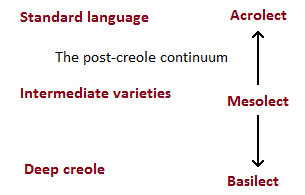Pidgin and creole Spanish – overview
A pidgin is the unstable and simplified form of a language that can emerge as a rudimentary means of communication among speakers with different mother tongues. A pidgin may come into existence as a consequence of trading activities between different nations or ethnic groups, but a more sinister cause, and one that is particularly associated with the colonial Americas, is slavery. Given that the black slaves thrown together on plantations or in slave depots were typically drawn from a wide range of ethnic groups, it was only to be expected that pidginized forms of the colonial European languages would frequently emerge as lingua francas.
A pidgin may in
due course stabilise, at the same time extending its grammatical and lexical
resources. The term creole is applied
to those extended pidgins that have acquired mother tongue status. If the
creole comes to be viewed as a substandard variety of the lexifier language – the language that provides the bulk of the
creole’s vocabulary – and if sufficient contact exists between creole and
lexifier, certain varieties of the creole may approximate towards the lexifier.
In such cases, one may speak of a post-creole
continuum, with the pure creole or basilect occupying one end of the spectrum, the lexifier or acrolect occupying the other end and a range of intermediate
varieties or mesolects in between.
The process whereby the creole gradually approximates to the lexifier is known
as decreolization.
those extended pidgins that have acquired mother tongue status. If the
creole comes to be viewed as a substandard variety of the lexifier language – the language that provides the bulk of the
creole’s vocabulary – and if sufficient contact exists between creole and
lexifier, certain varieties of the creole may approximate towards the lexifier.
In such cases, one may speak of a post-creole
continuum, with the pure creole or basilect occupying one end of the spectrum, the lexifier or acrolect occupying the other end and a range of intermediate
varieties or mesolects in between.
The process whereby the creole gradually approximates to the lexifier is known
as decreolization.
It appears that
no more than three Spanish-based creoles survive: Palenquero, spoken in Palenque de San Basilio, located about 50
miles south of Cartagena, in Bolívar province, Colombia; Papiamentu spoken on the islands of Curaçao, Aruba and Bonaire,
which currently form part of the Netherlands Antilles; and Chabacano or Philippine Creole Spanish, which is really a group of
mutually intelligible dialects, the best-known being Zamboangueño.